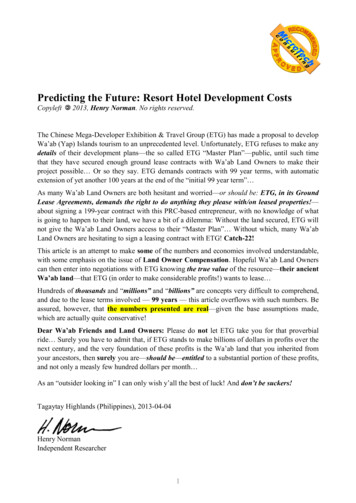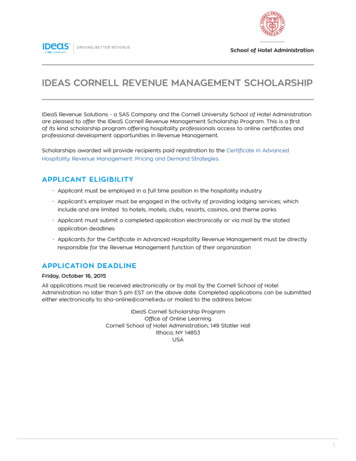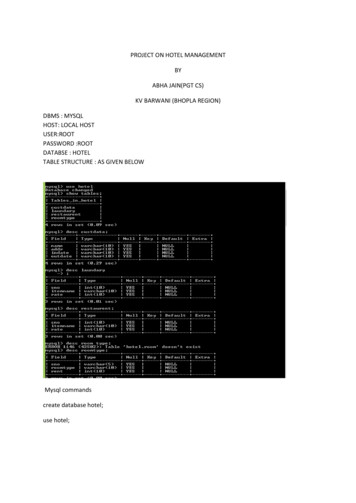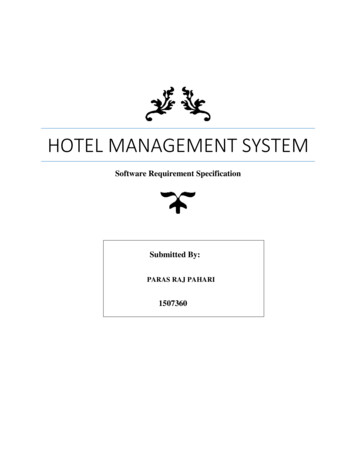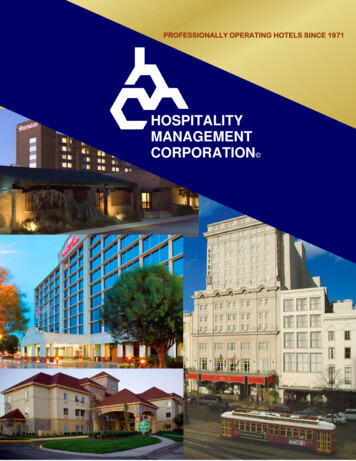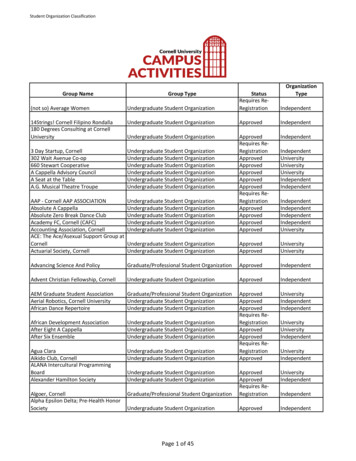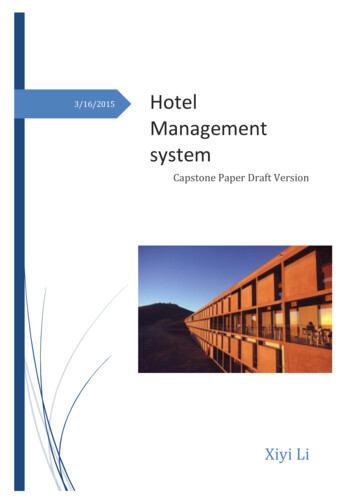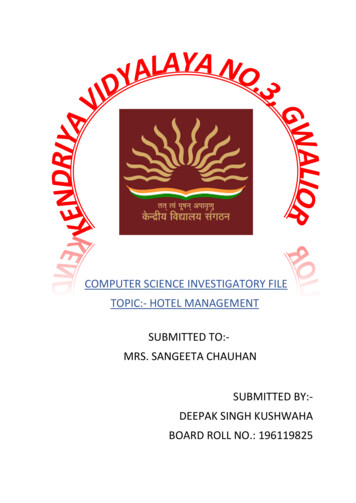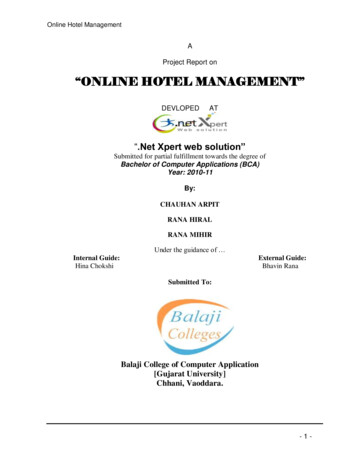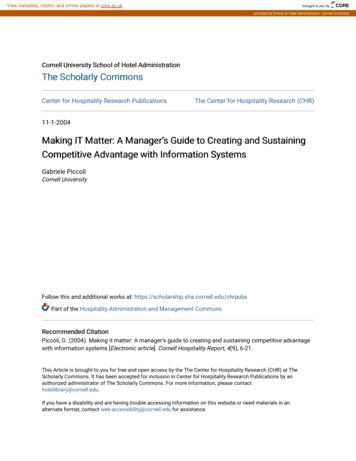
Transcription
View metadata, citation and similar papers at core.ac.ukbrought to you byCOREprovided by School of Hotel Administration, Cornell UniversityCornell University School of Hotel AdministrationThe Scholarly CommonsCenter for Hospitality Research PublicationsThe Center for Hospitality Research (CHR)11-1-2004Making IT Matter: A Manager’s Guide to Creating and SustainingCompetitive Advantage with Information SystemsGabriele PiccoliCornell UniversityFollow this and additional works at: https://scholarship.sha.cornell.edu/chrpubsPart of the Hospitality Administration and Management CommonsRecommended CitationPiccoli, G. (2004). Making it matter: A manager’s guide to creating and sustaining competitive advantagewith information systems [Electronic article]. Cornell Hospitality Report, 4(9), 6-21.This Article is brought to you for free and open access by the The Center for Hospitality Research (CHR) at TheScholarly Commons. It has been accepted for inclusion in Center for Hospitality Research Publications by anauthorized administrator of The Scholarly Commons. For more information, please contacthotellibrary@cornell.edu.If you have a disability and are having trouble accessing information on this website or need materials in analternate format, contact web-accessibility@cornell.edu for assistance.
Making IT Matter: A Manager’s Guide to Creating and Sustaining CompetitiveAdvantage with Information SystemsAbstractSome industry observers have suggested that information technology (IT) has lost its ability to be astrategic resource for modern organizations. However, such examples as Harrah’s and Ritz-Carltonpresent evidence to the contrary. Harrah’s has used IT to gather substantial business intelligence andidentify its best customers, while Ritz-Carlton uses IT to personalize every guest room and every stay forits returning customers. Many other firms outside the industry, such as Dell, eBay, and Lands’ End, providefurther evidence of how sustained competitive advantage can be built around IT. While the task is noteasy, when firms are successful in doing so the rewards can be tremendous.Keywordsinformation systems, information technology, high-speed internet access (HSIA) capability, added valueDisciplinesBusiness Hospitality Administration and ManagementCommentsRequired Publisher Statement Cornell University. This report may not be reproduced or distributed without the express permission ofthe publisherThis article is available at The Scholarly Commons: https://scholarship.sha.cornell.edu/chrpubs/187
CHR ReportsTheCenterforHospitalityResearch.orgMaking IT Matter:A Manager’s Guide to Creating andSustaining Competitive Advantage withInformation SystemsBy Gabriele Piccoli, Ph.D.The Center for Hospitality ResearchATCORNELL UNIVERSITY
Making IT Matter:A Manager’s Guide to Creating and Sustaining CompetitiveAdvantage with Information Systemsis produced for the benefit of the hospitality industry byThe Center for Hospitality Research at Cornell UniversityAdvisory BoardGary M. Thompson, Executive DirectorGlenn Withiam, Director of Publication ServicesRoger Cline, Chairman and CEO, Roundhill HospitalityJan A. deRoos, Ph.D., HVS International Professor ofFinance and Real Estate, Cornell UniversityBjorn Hanson, Ph.D., Global Hospitality IndustryManaging Partner, PricewaterhouseCoopersUnmesh Joshi, Chairman and Managing Director,Kohinoor GroupJo-Anne Kruse, SVP, Human Resources, CendantInternationalCraig Lambert, SVP Portfolio Management, CNLHospitality GroupMark V. Lomanno, President, Smith Travel ResearchLeland C. Pillsbury, Chairman and CEO, The ThayerGroup of CompaniesAngel Santos, VP of Marketing for Healthcare andHospitality, JohnsonDiverseyJanice L. Schnabel, Senior Vice President, Marsh’sHospitality PracticeDavid A. Sherf, SVP, Real Estate and InvestmentAnalysis, Hilton Hotels CorporationJudy A. Siguaw, D.B.A., J. Thomas Clark Professor ofEntrepreneurship and Personal Enterprise, CornellUniversityBarbara Talbott, EVP Marketing, Four Seasons Hotelsand ResortsElaine R. Wedral, President, Nestlé R&D Center andNestlé PTC New MilfordR. Mark Woodworth, Executive Managing Director,The Hospitality Research GroupMaking IT Matteris CHR Reports, Vol. 4, No. 9 (November 2004)Single copy price US 50.00Copyright 2004 by Cornell University
Thank you to our generous corporate supporters.Senior PartnersJohnsonDiverseyNestléPartnersAIG Global Real Estate InvestmentBartech Systems InternationalCendant CorporationFour Seasons Hotels and ResortsKohinoor GroupMarsh’s Hospitality PracticeThayer Group of CompaniesSponsorsWillowbend Golf ManagementWyndham InternationalFriends ARAMARK DKShifflet & Associates ehotelier.com Global Hospitality Resources HospitalityWorld hospitalitynet.org Hotel Asia Pacific Hotel China Hotel Interactive Hotel Resources InternationalCHRIE Lodging Hospitality Lodging Magazine Mobile MoneySaver National Hotel Executive Magazine Resort Recreation RestaurantEdge.com Shibata Publishing Co. Smith Travel Research The LodgingConference The Hospitality Research Group of PKF Consulting TravelCLICK UniFocus rg
Executive SummaryMaking IT Matter:A Manager’s Guide to Creating and Sustaining Competitive Advantagewith Information SystemsBy Gabriele PiccoliSOME INDUSTRY OBSERVERS have suggested that information technology (IT) has lost its ability to bea strategic resource for modern organizations. However, such examples as Harrah’s and Ritz-Carltonpresent evidence to the contrary. Harrah’s has used IT to gather substantial business intelligenceand identify its best customers, while Ritz-Carlton uses IT to personalize every guest room and every stay for its returning customers. Many other firms outside the industry, such as Dell, eBay, andLands’ End, provide further evidence of how sustained competitive advantage can be built aroundIT. While the task is not easy, when firms are successful in doing so the rewards can be tremendous.To exploit the strategic potentialof IT managers must:(1) Realize that there is a fundamental difference between information technology andinformation systems;(2) Clearly differentiate strategic informationsystems from tactical information systems;(3) Evaluate the role of IT in creating value andfocus on the design and implementation ofIT-dependent strategic initiatives ratherthan on IT investments;(4) Evaluate how the resources at the disposalof their firm combine with competitors’structural inadequacies to create the potential for value creation and appropriation;4 M AKING IT M ATTER(5) Evaluate how to exploit the characteristics ofthe IT development and implementation lifecycle to estimate the extent of response lag ascompetitors attempt to imitate the initiative;(6) Evaluate how to exploit the characteristicsof the value system in which their firm isembedded to preempt competitors’ responseand create obstacles to replication; and(7) Evaluate the evolutionary paths availableto the firm to reinforce barriers to erosionof competitive advantage associated withIT-dependent strategic initiatives.This report offers a framework that can helpmanagers formally analyze existing and proposedIT-dependent strategic initiatives and offers a seriesC ORNELL U NIVERSIT Y THECENTERFORHOSPITALIT YRESEARCH .
of questions to guide the analysis. The frameworkbegins with the following background questions:(1) Is the proposed initiative aligned with thefirm’s strategy?;(2) Is the proposed initiative designed to reducethe firm’s costs or to increase customers’ willingness to pay?; and(3) What is the IS design underpinning theproposed initiative?With the answers to those questions in hand,a manager can continue the analysis with the following questions regarding the extent to whichthe competitive advantage arising from the ISinitiative is sustainable.(4) What competitors are appropriately positioned to replicate the initiative?;(5) How long before competitors have the samefunctionality in place?;(6) Will replication do competitors any good?;and(7) What evolutionary paths does the innovationcreate that the innovator can exploit?Finally, having concluded the backgroundand sustainability analysis, the manager can makeone of the following three determinations aboutthe proposed IS strategic initiative:(1) Develop the IT-dependent strategic initiativeindependently, if the competitive advantageis deemed sustainable;(2) Develop the IT-dependent strategic initiativeas part of a consortium, if the competitiveadvantage is not sustainable, but the business and the industry as a whole will profitfrom the initiative; or(3) Shelve the proposed initiative, if competitors’ response will degrade value-appropriation potential for all.THECENTERFORHOSPITALIT YRESEARCH . ORGAbout the AuthorGabriele Piccoli,Ph.D., is anassistant professorof informationsystems at theCornell UniversitySchool of HotelAdministration.Widely published ininformation systemsand information technology journals, hisresearch and teaching expertise is onthe strategic application of informationtechnology, electronic commerce, and ITenabled customer service. C ORNELL U NIVERSIT YM AKING IT M ATTER 5
CHR ReportsMaking IT Matter:A Manager’s Guide to Creating andSustaining Competitive Advantage withInformation SystemsBy Gabriele PiccoliTHOSE AMONG US WHO HAVE BEEN CONCERNED WITH INFORMATION TECHNOLOGY (IT) forless than a decade may think that the IT community is facing challenges neverthrown its way before. After all, how do you respond to accusations of the kindfound in the article titled, “IT Doesn’t Matter,” published in the Harvard Business Review?1To be sure, there is evidence that manyhospitality firms are not using IT strategicallyand are not achieving benefits commensuratewith the substantial sums of money being expended on IT. As an example, a recent study byMcKinsey concluded that after spending 7.6billion in IT between 1995 and 2000, the lodging industry saw no increase in revenue (aftercontrolling for the effects of the booming economy) and no tangible increase in productivity. 2The uncertainty many executives feel abouthow to wrest value from their IT investmentsinspired this report. Surveys have historicallyshown remarkable consistency with the findingthat the average executive feels that IT decisions are well outside of her or his comfort zone.Compounding this problem is the historical fact that the information systems (IS) function has traditionally been led by technologists. Because of the vastly different backgroundand knowledge base of the business executives and the technology executives, the result6 M AKING IT M ATTERhas often been failed communication and adelegation of “all IT issues” to technologists.More recently, we have witnessed a trendreversal, with the IS function being led by many“new school” CIOs, who are well versed in thebusiness. While this is a step in the right direction,it is hardly enough, for all executives must careabout IT. As the SVP of sales and marketing of abranded lodging company recently told me: “Everymanager must have an IT strategy. You can’t delegate to technologists and only worry about yourallocated cost or what training your employeesneed. You must understand how to be master ofyour own destiny and make IT work best for you.”1Nicholas G. Carr, “IT Doesn’t Matter,” HarvardBusiness Review, May 2003, pp. 5–12; HBR stirred thatsame pot in similar fashion in 1972 with an article titled “MIS Is a Mirage,” and in 1966 with a piece titled,“The Myth of Real-Time Management Information.”2P. Brown and K. Stange, “Investment inInformation Technology: The Multi-Billion DollarGame of Chance,” Hospitality Business Review, 2002.C ORNELL U NIVERSIT Y THECENTERFORHOSPITALIT YRESEARCH .
This is because, as talented as today’s CIOsare, they are not spending their time addressingoperations problems the way COOs do, marketing problems the way CMOs do, or financialproblems the way CFOs do. Mind you, this isnot a call for hospitality executives to becomeIT technicians. Instead, I believe that knowinghow to use IT strategically does not so much involve a deep understanding of how technologyworks (even though a bit helps) as it does a deepunderstanding of how IT can be used to createand to appropriate economic value.As I demonstrate in this report, quibblingabout whether IT matters is a waste of time. ITdoes matter, of course, and companies like eBay,Dell Computers, and Wal-Mart have amply demonstrated that it does. Wal-Mart, for instance,leveraged IT to create an unparalleled inventorycontrol system. Dell has succeeded with a highvelocity built-to-order model, while eBay usestechnology to enable its position as the primaryonline auction site (arguably the only such site).The travel and tourism industries have also hadtheir share of IT success stories: American Airlines’SABRE is the stuff of legends, and Radisson’slook-to-book initiative has also proven quitesuccessful. Other recent examples include RitzCarlton’s personalization strategy and Harrah’sEntertainment’s business-intelligence initiative.The real question then is: What do managersneed to know to make IT work strategically fortheir company? This report answers that question.The report starts with a crucial differentiation between information systems (IS) andinformation technology (IT). It then focuseson strategic information systems and how theycan be used to create and appropriate economicvalue. After discussing established frameworksfor value creation, I introduce the notion of barriers to replication. Using this concept I showhow innovative IT-based initiatives can be analyzed to evaluate their potential for sustainableadvantage. The report concludes with a seriesof key questions that management must ask toassess the sustainability of any IT-enabled strategic initiative. The answers to those questionswill tell management how to proceed with theinitiative, and, indeed, whether to proceed at all.For those managers who find their company trailing an innovator, the framework helps decidingwhether to imitate and, if so, how to best proceed.THECENTERFORHOSPITALIT YRESEARCH . ORGNot All IT Is Created EqualOver 35 years of information-systems researchhas demonstrated that not all technologies arecreated equal or behave the same—particularlywhen used strategically. An example will show howdifferent technologies can produce dramaticallydissimilar results from a competitive standpoint.High Speed Internet AccessDuring the dot.com days of the late 1990s, asthe number of internet users was increasing at astaggering rate, a host of providers began to offerin-room high-speed internet access (HSIA) capability to hotels. Soon HSIA became one of thehottest technologies to hit the lodging industry ina while, with hotels implementing the technologyand offering it as a paid amenity ( 9.95 for unlimited use being the most popular pricing option).Understanding the differencebetween informationsystems (IS) and informationtechnology (IT) is crucial tousing IT strategically.While take rates were much lower thanexpected, HSIA quickly became a “must-offer”amenity, based on the assumption that businesstravelers, who were used to high-speed connections at home and in the office, would snub hotelsthat could not have them surfing in the fast lane.The inevitable result was an increasingnumber of properties that offered HSIA free asan amenity. For example, in February 2001 theSheraton Vancouver Wall Centre announced thatit was offering HSIA free of charge to all guests.In the press release introducing the initiative theHSIA vendor declared: “Offering this serviceas an amenity with no charge to the guest willcertainly differentiate the Sheraton VancouverWall Centre from its competitors.” Any hopedfor differentiation did not last long, however, asmore properties joined the “free amenity” band- C ORNELL U NIVERSIT YM AKING IT M ATTER 7
wagon. Soon this amenity moved to the brandlevel, with, for example, Omni Hotels offeringit system-wide to all guests starting in February2003 and Best Western following suit in 2004.Following the trend of countless amenitiesbefore it, HSIA is rapidly becoming a cost of doingbusiness for hotels, because (as I explain below)it cannot be protected and customers have appropriated the added value from this IT innovation.Business Intelligence at Harrah’sEntertainmentHarrah’s Entertainment has been recently widelycelebrated for its innovative use of IT in support of its efforts to better understand its customers—a type of initiative known as businessintelligence. To do so, Harrah’s had to investheavily in technology solutions—an investmentestimated to exceed 100 million in 2000. Suchexpenditure may seem huge, but the firm madea trade-off decision not to invest in propertiesthat would wow visitors with their size andelaborate design, and instead used the moneythus saved to create a sound technologicaland organizational brand-wide infrastructure.Technology is only the beginning of thisstory though. Harrah’s did not simply buy abunch of computer systems, flip on the switch,and watch the dollars roll in. Instead, the firmembarked on a bold reorganization, centralizingand focusing operations around the brand andaway from individual property interests. As partof the reorganization Harrah’s hired a new breedof analysts, known as decision scientists. Theseindividuals had the mindset and the skills to gatherand analyze data about gamblers’ characteristicsand activities. By carrying out scientific experiments, Harrah’s was able to become both moreefficient (i.e., spend less) and effective (i.e., spendbetter) in its use of funds to attract and retaincustomers, while also increasing share-of-wallet.The returns on this use of technology havebeen considerable for Harrah’s, even in the faceof a slowing economy. At the same time, thecentralized IT infrastructure and the processesit has developed enable Harrah’s to expand itsdistribution with relative ease and control. ForHarrah’s Entertainment, then, IT does matter!If nothing else, the above examples raisethe questions of whether managers should approach distinct IT-based initiatives differently8 M AKING IT M ATTERfrom each other. Put another way, does IT matter sometimes but not others?Two Fundamental PremisesAnalyzing the strategic potential of IT beginswith establishing two fundamental premises:first, IS IT; and, second, exactly what it isthat constitutes a strategic information system.IS ITWithout doubt, information technology engendersa plentitude of confusing lingo, technical terms,and acronyms—a problem compounded by thewealth of half-prepared, fast-talking individuals using terminology incorrectly. Of all the potentiallyconfusing terms, none is more insidious than theterm information system, usually abbreviated IS.In this context, information system is often usedas a rough synonym for information technology.But there is a critical difference between IT andIS. Information technology is a component—albeita fundamental one—of an information system.The distinction between IS and IT is clarified by the following simple example. The famousPlaza Hotel in New York City opened its doorson October 1, 1907.3 Did the Plaza have an information system when it was inaugurated? Theanswer is yes, of course. The Plaza’s informationsystem allowed it to take reservations, to checkguests in and out, to keep track of room status,and to manage its inventory of amenities andequipment. Yet, the first known front-office implementation of IT in a hotel (that is, a computersystem) did not occur until June 27, 1963, whenthe New York Hilton introduced its card-readerbased, batch-processed front-desk system.4 Clearly,while information technology is a fundamentalcomponent of any modern information system,IT and IS are not synonyms.3See: www.fairmont.com.4See: Charles I. Sayles, “New York Hilton’s Data-processingSystem,” Cornell Hotel and Restaurant Administration Quarterly,Vol. 4, No. 2 (August 1963), p. 41; and Roy Alvarez, Dennis H.Ferguson, and Jerry Dunn, “How Not to Automate Your FrontOffice,” Cornell Hotel and Restaurant Administration Quarterly,Vol. 24, No. 3 (November 1983), pp. 56–62. Interestingly,the system was not speedy enough for the New York Hilton’sneeds, and within a year the hotel had to remove the frontdesk computers—until IT caught up with the hotel’s IS needs.C ORNELL U NIVERSIT Y THECENTERFORHOSPITALIT YRESEARCH .
With this example in mind, I define an information system as a socio-technical system thatincludes IT, processes, people, and organizationalstructure. All four components are necessary todeliver the information-processing functionalities of the IS. More important, any change inone component (e.g., a new software program,a change in organizational structure from property-centric to brand-centric) will affect andrequire adjustment in each of the other components—that is, any change has systemic effects.The distinction between IT and IS is fundamental toward understanding the strategic potential of information systems and of technology.With the distinction between IT and IS clarified,it should be evident why the firm that focusessolely on IT investments to become competitive (i.e., blindly purchasing computer systems)is wasting its money. IT investments make senseonly as components of information systems whoseinformation-processing functionality is thoughtto lead to an improved competitive position.Adding Strategic to InformationSystemsThe second fundamental premise is to establishwhat aspects of an information system make itstrategic. The foremost objective of strategy in forprofit business ventures is to achieve and sustainsuperior financial performance. To do so the firmuses its resources to create value by either reducingcosts5 or by increasing the customers’ willingnessto pay for its product or services. A firm achievescompetitive advantage when it is able to createdistinctive value that no other firm offers bycreating a positive difference between customers’willingness to pay and the firm’s costs. At thatpoint, the firm is in a position to appropriate theadded value it has created in the form of profits.As competitive dynamics play out, the firm’scompetitors will try to replicate or substitute theinnovator’s value-adding strategy. When competitors succeed in copying the innovator, it will face5Strictly speaking, value creation is the difference betweencustomers’ willingness to pay (the maximum amount of moneycustomers are willing to give to the firm to obtain its products andservices) and supplier opportunity cost (the minimum amountof money the firm’s suppliers are willing to accept to work withthe firm). For simplicity I use the actual firm cost as a proxyfor supplier opportunity cost as actual cost is more intuitive.THECENTERFORHOSPITALIT YRESEARCH . ORGprice pressure leading to customers’ appropriation of value—as is occurring with free HSIA.Strategic information systems are those thatenable the creation of the distinctive added value. The following two key insights follow fromthis definition of strategic information systems.(1) Strategic information systems are not defined by their functionality or the organizationalfunction they support, but instead they are definedin terms of their objectives and the purpose theyserve—improving the firm’s competitive standing.(2) Contrary to conventional wisdom, strategic information systems do not have to rely onproprietary technology. eBay, for example, hasdominated the online auction market since itsinception using commonly available technology,namely, the internet. A simple look at competitors’ auction sites (e.g., Yahoo!, Amazon.com)Information technology hasspawned a plentitude ofconfusing lingo, but the importantconcept is that an informationsystem includes informationtechnology, as well as people,processes, and organizationalstructures.reveals that they offer comparable functionalities.The key lesson here is that what needs to be distinctive and hard to imitate is the value-creatingstrategy that is built on a specifically designedinformation system of which the technology isa fundamental component. As I discuss below,replicating the IT at the core of defendable strategic information systems is often a useless move.The definition of strategic information systemsgiven here is useful in discriminating the manysystems that are not strategic. These are systemsthat do not position the firm to create distinctivevalue, even though they are important and sometimes crucial for the business’s operations. I referto these as tactical systems. Some examples follow. A restaurant’s fundamental information system,anchored by its POS, which is used to managereservations, seating, order taking, and delivery, is crucial to the operation of modern res- C ORNELL U NIVERSIT YM AKING IT M ATTER 9
Similarly, no matter how well it is run, an email system is unlikely to be the foundationof a strategic information system. The sameargument can be made for productivity software such as Microsoft Word and Excel, nomatter how advanced their features may be.Implementing or upgrading tactical systems will therefore not create strategic advantage. Thus the following two key questionsremain. How can IT be used to create added value? How can the firm ensure its abilityto appropriate the value created over time?its comp budget, Harrah’s has saved enoughmoney to pay for the technology. An exampleof a strategy that increases customers’ willingness to pay is that of Wyndham ByRequest. Fora segment of business travelers, namely thosefrequent travelers that don’t travel often enoughto redeem competitors’ points, the instant gratification offered by Wyndham ByRequest mayoffer considerable value. Converting these frequent guests to loyal Wyndham customers isa way for Wyndham to appropriate the valueit created, without having to increase rates.6The key insight is that the companies involved focused not on the technology but onwhat I term IT-dependent strategic initiatives. ITdependent strategic initiatives are those projectsthat rely heavily on IT (i.e., they cannot feasiblybe enacted without investments in IT) to createadded value. IT-dependent strategic initiativesconsist of the configuration of an activity systemthat is enabled by IT and is designed to createand appropriate economic value. Typical strategicinitiatives include business-process reengineering,customer-relationship management, organizational learning, knowledge management, electroniccommerce, electronic business, and infrastructure initiatives, as well as such limited programsas introducing internet cafés on cruise ships.A number of frameworks have been advanced over the years to help managers in evaluating and developing IT-dependent strategicinitiatives. In the remainder of this section Ihighlight some of those frameworks with references to material that describes them in depth.How IT Can Create Added ValueCritical Success FactorsIn the course of explaining the nature of hospitality IT applications, I have hinted at the waysthat some operations have used informationsystems to create added value. In the examplesthat follow, I point out in greater detail howtechnology can be used to create value by eitherreducing the firm’s costs or by increasing the customers’ willingness to pay for the firm’s productor services. Returning to the case of Harrah’sEntertainment, here is an example of a strategythat creates value by reducing the firm’s cost.Drawing on the information provided by guestswho use their total rewards cards, Harrah’s hasbeen able to fine tune its use of comps. By someaccounts, with its ability to efficiently disburseThe critical-success-factor (CSF) methodologyfocuses on the use of information systems to furthera business’s key performance drivers.7 Thus, the taurants. A system such as this is generally tactical, because it rarely creates distinctive value.Likewise, a hotel’s fundamental information system, built around the PMS it usesto manage room reservations, is crucial tooperations. Even though it’s unlikely that anyhotel beyond a tiny property could efficientlyrun without such a system, it is tactical, forit generally does not create distinctive value.Hotel companies can useinformation technology tocreate and appropriate added valuewhen their strategic initiativesbuild barriers to erosion. 10 M AKING IT M ATTER6This example helps to highlight the fundamental insightthat price decisions are consequential to value creation. Tocreate value a firm needs to do something customers value,so that they are willing to pay for it. Simply raising pricesis not a value-creating strategy. On the other hand, havingcreated value, the firm can increase prices or find other waysto appropriate it. For example, while Wyndham may leaverates unchanged, every loyal customer who books on thecompany website (instead of through a third party) createsmuch more flow-through to the bottom line, thus allowing Wyndham to appropriate some of the value it created.7J. Rockart, “Chief Executives Define their Own Data Needs,”Harvard Business Review, Vol. 57 (March–April 1979), pp. 81–93.C ORNELL U NIVERSIT Y THECENTERFORHOSPITALIT YRESEARCH .
CSF approach calls for evaluating whether an ITdependent strategic initiative will have a favorableeffect on those drivers. This approach enablesthe firm to prioritize initiatives in a structuredfashion based on accepted drivers of performance.Value ChainThe classic value-chain model shows how information can be used at any stage of the value-creation process to lower costs, enhance differentiation, or support relationships among differentfirms in a value system. 8Virtual Value ChainThe virtual value chain (VVC) model focuses onthe use of information to create value.9 It showshow managers can use the substantial amount ofinformation that is typically generated during thecourse of business and transform it into valuableinsights, new processes, or new products or services.Cu
abriele Piccoli, Ph.D., is an assistant professor of information systems at the Cornell University School of Hotel Administration. Widely published in information systems and information technology journals, his research and teaching expertise is on the strategic application of info
